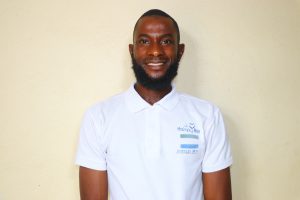The 251 residents of the Mabom Community have to make a perilous and difficult journey to access water that is likely to make them sick.

"The road leading to these sources has a footpath, and it is hilly. This makes it difficult for the community members, especially the children, to fetch water. They find it difficult to climb the hill, especially when carrying a bucket of water on their heads. Sometimes, people get stuck and then get injured or damage the rubber bucket, especially the children or elderly people," shared Field Officer Alie Kamara.

"The community members are walking a long distance to access these water sources. As a result, they get fatigued, and pain on their head or hurt their legs. This will cause them to be less proactive in doing other activities. They will not complete their targeted routine. Hence, these water sources are located near the bush, and this exposes the community to snake bites. Bowing down to collect water from these sources puts the children's lives at risk [of] drowning in the water," Alie continued.
Fudia is thirteen years old and struggles through her community's water crisis daily. With the distant scoop hole being her only option for fetching water, she is forced to face her fears and make the treacherous hike multiple times a day.

Fudia at the scoop hole.
"I am worried about safety at the water source. There are snakes in the bush, and they [are] always looking for food to eat. So, [if] I come across a snake, it will bite me. This makes [me] always afraid of going to the swamp to collect water. Snakes always get close [to] the footpath, and there is a great chance to bite you," she shared.
Not only does Fudia live in fear for her safety, but all the time spent collecting water detracts from her education. This situation is really frustrating for her.
"Yes! It impacts my time at school. I do not go to school quickly, and I am late to go to school. I spend much time at the water source to collect water due to the distance. After I get off from school, I go to the swamp to collect water, and this will cause me not to be able to spend much time studying or even not to study. This will cause me not to perform well in my school," she said when we asked if her education is impacted by the water crisis.

Fudia collecting water.
Field Officer Alie shared, "The moment that impacted me was going to the water sources with the water users. When I saw the hill they usually climbed and the water sources they get to drink put their lives at risk. Climbing the hill and going down the hill is not funny it requires energy, and you should be strong enough to collect water from these sources because of the hill."
Installing a new borehole well in the center of the community will give Fudia time to pursue her education and eliminate the community's fears for their safety, as they won't have to trek to the scoop hole anymore.

Fudia.
"I will be safe from going to the swamp to collect water, where I have to climb the hill up and down. I will not be exposed to snake bites. A new waterpoint will put all these to the past. My future is wanting to be a nurse to serve my people and save my community people," Fudia concluded.
Steps Toward a Solution
Our technical experts worked with the local community to identify the most effective solution to their water crisis. They decided to drill a borehole well, construct a platform for the well, and attach a hand pump.
Well
Abundant water often lies just beneath our feet. Aquifers—natural underground rivers—flow through layers of sediment and rock, offering a constant supply of safe water. A borehole well is drilled deep into the earth to access this naturally filtered and protected water. We penetrate meters, sometimes even hundreds of meters, of soil, silt, rock, and more to reach the water underground. Once found, we construct a platform for the well and attach a hand pump. The community gains a safe, enclosed water source capable of providing approximately five gallons of water per minute. Learn more here!
Community Education & Ownership
Hygiene and sanitation training are integral to our water projects. Training is tailored to each community's specific needs and includes key topics such as proper water handling, improved hygiene practices, disease transmission prevention, and care of the new water point. Safe water and improved hygiene habits foster a healthier future for everyone in the community. Encouraged and supported by the guidance of our team, a water user committee representative of the community's diverse members assumes responsibility for maintaining the water point, often gathering fees to ensure its upkeep.

 Borehole Well and Hand Pump
Borehole Well and Hand Pump
 Rehabilitation Project
Rehabilitation Project
















